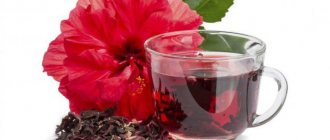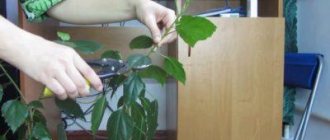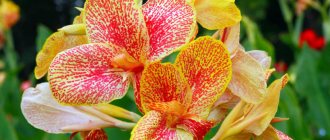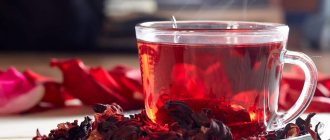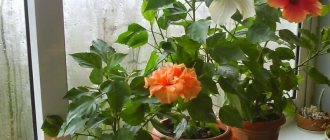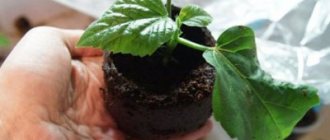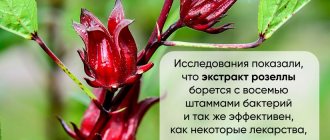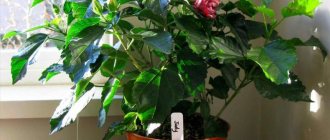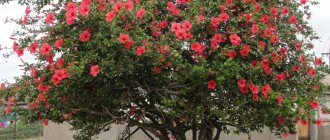Syrian tree hibiscus is also known as garden hibiscus. It looks like a fairly compact shrub, about 3 meters high. The inflorescences are saucer-like, flowering begins in the second half of summer to the beginning of autumn. The inflorescences are ordinary, sometimes double. The color is pink, white, red. The frost-resistant hibiscus plant can withstand temperatures down to -25 degrees. But for good abundant flowering, constant warm weather is necessary. Hibiscus prefers a sunny place and grows well in neutral soil.
Description of Syrian tree hibiscus
Syrian hibiscus (Hibiscus) is a plant from the Malvaceae family; its second name is garden (street) rose or Sharon. Syrian hibiscus (you will see the photo below) is a tree-like shrub with a height of 2 to 6 meters, depending on the variety. The stem is thick, has a tree-like shape, the branches are erect, not branching.
The flower has green, ovoid, medium-sized leaves with jagged edges. Hibiscus blooms with beautiful single simple and double flowers. Flowers can be of different colors: from white to crimson, sometimes bicolor.
A photo in the garden with this exotic plant looks great. Although hibiscus grows slowly, many gardeners strive to grow it.
A distinctive feature characteristic of many varieties of garden hibiscus is the late flowering time, which occurs from the end of July to October inclusive. This feature and the exotic appearance of the flowers have contributed to the fact that this plant has become a real miracle of the passing summer in many gardens and household plots. Quite common among gardeners is the tree hibiscus. Photos of this beautiful plant can be seen in many gardening websites and magazines.
Quite large flowers that form on the shoots of the current year can be double, half-double, simple, with petals wavy at the edges, two-color or plain, with an eye of a contrasting color. All this depends on the plant variety.
To get a beautiful hibiscus in the garden, it is important to carefully prepare for planting it. It is necessary to purchase good seedlings of this plant and choose the right place on the site for planting. Care should also be taken to properly prepare the soil for this luxurious exotic miracle of nature.
Benefit
Syrian hibiscus is a wonderful ornamental plant that, with proper care, will grow and delight you for up to 20 years. This plant is ideally suited for creating hedges, border plantings, group compositions, for decorating artificial reservoirs, and masking design flaws.
Syrian hibiscus (indoor plants) can be safely grown at home; it blooms very beautifully, will decorate your room and please the eye.
Distinctive features and varieties
In central Russia, the most widespread is the Syrian rose - hibiscus, which is distinguished by its winter hardiness and ease of cultivation. This unpretentious flower loves warmth and light, but is afraid of excessive humidity and drafts.
Swamp hibiscus: planting and care in open ground
Flowering period - late July-early September. A large number of flower buds are formed. And, despite the fact that the lifespan of the bud is one day, wilting is not noticeable, and the appearance of the plant does not deteriorate.
Important! Indoors, it is optimal to grow “guest from Syria” on windows facing south. In the summer, he will be glad to move to the balcony, closer to the sun and natural light.
In the gardens of the Urals and central Russia, the deciduous shrub grows up to 1.5-2 m in height. The flowers reach 7-12 cm in diameter and can be one-color or two-color.
The most popular types:
- Hybrid (garden, herbaceous). Obtained in the mid-20th century. Winter-hardy, straight-trunked. From the ground to the top it reaches 1-1.7 m. The buds are 12 cm in diameter and bright pink. The foliage is emerald-amber. May be annual.
- Youth. A weakly branched bush up to 1.5 m high. It is distinguished by the yellow-malachite color of the shoots growing at an angle of 60°, and by snow-white flowers 10 cm in diameter, shaped like a tulip.
- Late. A compact shrub measuring 1x1 m. Leaves with whitish veins and jagged tips fit tightly to each other. Among others, they stand out for their oval arrow-shaped shape, low pedicels and narrow bell-shaped inflorescences of raspberry-pinkish and lilac tones with a volume of 7 cm.
- Pale pink. Height 170 cm. The shoots are small, located at an angle of 60°. Serrated yellow-green cut foliage. The buds are 12 cm in circumference in the form of a tulip with a white bottom and pink “walls”.
- Pink-porcelain reaches a height of 130 cm. The bush has amber-green branched long stems and deeply incised leaves (6 cm), as well as pale pink rosettes resembling bells with barely visible yellowness and a boiling white pharynx with a diameter of 12 cm. The inflorescences are united in brushes on a low stalk.
- Indoor, or Chinese rose. Bred for greenhouses, gardens, rock gardens and rose gardens. Breeding in a home microclimate and greenhouses will also be optimal. Blooms all year round.
- Bolotny. These are large flowers 12 cm in diameter. Looks great as a hedge.
- Sour. Another name for annual maple. The bush is characterized by wedge-shaped carved leaves and red petals. It fits harmoniously into landscape design as an independent element, and is also used to build a living fence.
Note! When purchasing a seedling for open ground, a sprout with non-double petals would be preferable as it is more frost-resistant.
Transplantation after purchase into open ground
The question of how to plant hibiscus most often arises among novice gardeners. Transplanting hibiscus after planting in open ground is not too difficult; the main thing is to follow all the rules, then the flower will delight you with its bright and long-lasting flowering.
What is needed for planting
Indoor Chinese rose (hibiscus) - varieties, care and propagation
Be sure to prepare the soil for planting. It should be fertile, nutritious soil with good drainage. Clay soil is strictly contraindicated because it retains moisture, as a result of which the roots of the plant rot, which leads to a slowdown in its growth and development.
Important! Root rot is one of the reasons why a hibiscus bush may dry out.
Before you start planting, you should prepare the soil - mix garden soil with peat. Additionally, it is recommended to apply organic and mineral fertilizers, as well as humus. This soil mixture must be thoroughly stirred and watered abundantly.
Choosing the optimal location
The optimal place will be a well-lit area, which will be sheltered from sharp gusts of wind and drafts. If you choose the wrong area where the tree is in the shade, you may not expect the hibiscus to bloom.
Step by step planting process
How to plant hibiscus:
- After the seedling is purchased, it is forbidden to water it. The substrate in the container must remain dry until transplantation.
- In a prepared place, you should dig a small planting hole, pour a little drainage on its bottom, then a layer of substrate prepared in advance, a little saltpeter on top, then more soil.
- The container in which the bush hibiscus is located needs to be tapped properly on the walls. This is necessary so that the seedling can be easily removed along with the earthen lump in which it grows.
- Transplantation is carried out using the transshipment method. This means that the seedling must be carefully removed from the pot, being careful not to touch or damage the root system.
- After the young plant is installed in the planting hole, all voids are carefully filled with the prepared soil mixture.
- Only the planted Chinese rose is watered abundantly. You need to pour at least 10 liters of water under each bush.
It is worth considering the size of the area where you plan to plant the plant. It should be spacious enough and free from other flowers and shrubs to allow a large enough hibiscus to grow and develop to its fullest.
Garden hibiscus seedling at the dacha
The volume of an adult plant will be at least a meter, so when planting several shrubs nearby, you need to leave a distance of at least 1.5 m between the planting holes.
Important! Be sure to install a support next to the hibiscus. It will be needed by both young shrub species and herbaceous and even tree forms.
Varieties of Syrian rose
Breeders have developed many species that differ in color, flower shape, height and bushiness. Herbaceous hibiscus has the largest flower stalks - up to 40 cm in diameter, can withstand frosts down to minus 30 degrees, so it overwinters well without shelter in the middle zone. It is characterized by accelerated growth - in one summer the plant can reach a height of 3 m with proper care and feeding.
Swamp hibiscus flowers are smaller - up to 18 cm in diameter, but this plant is not afraid of high groundwater and can grow in lowlands, where puddles collect in spring and autumn. There are about 200 species of swamp hibiscus, and some compact varieties can be grown indoors. Although considered an evergreen shrub, leaf fall is observed at temperatures below 10 degrees.
The shape of the peduncle with a long stamen resembles an indoor Chinese rose.
- Hibiscus Syrian Blue Chiffon is a variety whose main feature is the color of its flowers. This variety is often called “chiffon” because of the tenderness of its petals. Blue chiffon attracts attention, because in nature the blue color, clear and pure, practically does not occur with a transition to blue.
- Hibiscus Syrian Oziau blue. This variety also has blue flowers, but their central color is red.
- Hibiscus Syrian Matilda is memorable with a red spot on the pink petals of the flower.
- It is no coincidence that the Syrian Red Heart hibiscus is called “red heart”: the central part of its white flowers is red in color.
- Hibiscus Syrian Ardens is distinguished not only by the compactness of the bush, but also by its flowers. Each double flower is purple in color.
- Hibiscus Syrian Duc de Brabant is equally good both in the form of a bush and in the form of a tree, colored with purple and red petals.
Blue Chiffon
A light-loving variety with small leaf blades and small flowers of a beautiful blue hue.
It is moderately drought-resistant and tolerant of slight temperature drops.
Similarities with other colors
Hibiscus Syrian Blue Chiffon has some external similarities with other garden flowers:
- Calistegia terry is a herbaceous perennial climbing plant with beautiful velvety flowers.
- Chinese rose is intended for indoor cultivation.
- The climbing rose looks good next to the lush ketmia bush.
- Mallow is a 1-2 year old plant that does not tolerate low temperatures.
- Stockrose is a type of mallow that reaches a height of 2 m.
In separate articles, we talked about the charming tropical flower - the Syrian hibiscus Duke de Brabant, the magnificent ornamental variety Ardens, as well as the subvarieties of the Chiffon hibiscus - Magenta, White and other varieties.
The Syrian hibiscus variety Blue Chiffon is one of the most beautiful flowers among the amazing variety of representatives of the mallow family. With proper care and attention, it will give its owners many unforgettable moments with its aesthetic appearance.
Brief description of cultivation
- Landing. In spring, from mid to late May.
- Bloom. From the last days of June to the beginning of October.
- Illumination. Sunny areas are suitable.
- Priming. The soil should be nutritious, light and well drained. Hibiscus can be grown in areas where roses grow well.
- Watering. It is necessary to water systematically, especially on hot days, but do this only when the soil dries out. During the dry season, watering is carried out every day.
- Trimming. In early spring, before sap flow begins, rejuvenating, sanitary and formative pruning is carried out.
- Fertilizer. Hibiscus should be fed from June to September once every 2 weeks; for this purpose, mineral fertilizers with a high content of nitrogen and phosphorus are used. In autumn, potassium fertilizer should also be added to the complex.
- Reproduction. By cuttings, grafting, layering and seed method.
- Harmful insects. Thrips, spider mites, aphids and whiteflies.
- Diseases. Root rot and chlorosis.
Care
Caring for hibiscus, like planting this plant, does not require any special effort. This plant is quite unpretentious. It is required to perform a number of specific actions necessary for each ornamental flowering plant. If for some reason you cannot grow a flower, you should once again carefully pay attention to all aspects of planting and care.
Watering mode
The soil is moistened with well-settled warm water. Soft river water is preferable. A moderate watering regime is required; it is carried out as the top layer of soil dries. On hot, dry days, daily watering is recommended. In other weather conditions, the flower is watered 3 times a week.
Note! Hibiscus loves to water the leaves and stems with a hose. This will not only refresh the foliage, but also serve as prevention against a number of insect pests.
Watering garden hibiscus
Top dressing
Fertilizers should be applied at intervals of 2 times a month. During the next watering, dry mineral fertilizer is scattered over the soil, which penetrates into the soil thanks to moisture. It is also possible to feed with a solution of chicken manure, but it should be diluted in a ratio of 1:30 so as not to burn the tender roots of the plant.
Features of care during the flowering period
The flowering period occurs in the beginning and second half of summer. At this time, it is worth carefully monitoring the external condition of the flower, promptly removing inflorescences that have already withered, but for some reason did not fall to the ground. Flowers should be fed with potassium-phosphorus fertilizers, excluding mixtures containing nitrogen.
Features of care during the rest period
During the dormant period, fertilizing, on the contrary, is carried out with nitrogenous fertilizers, which stimulate the development of the above-ground green part of the plant and the growth of a denser, lush crown of the bush.
Preparing for winter
It is very important to properly prepare the flower for wintering. Don’t be afraid that in the fall the flower has shed its leaves. He always does this before wintering. In Central and Central Russia, freezing is unlikely with proper shelter.
Before covering the bush, it needs to be watered abundantly (12-15 l). Immediately after the soil dries, it needs to be hilled up as high as possible. Before this procedure, it is useful to add a little river sand to the soil. When the first frosts occur, the substrate is covered with several layers:
- shavings;
- sawdust;
- fallen dry leaves.
The branches are pressed to the ground as low as possible, and the flower itself is covered with several layers of special garden material. After this, a frame is built over it, on top of which a spruce forest and another layer of insulation are laid.
Important! Hibiscus will not survive in Siberian frost conditions, so it needs to be dug up and, together with a large lump of earth, moved into a large tub. Next, the plant is placed in the basement, its roots are insulated.
Garden hibiscus is a wonderful plant that is very easy to care for, and its flowering will delight the gardener for a long time. Any form of hibiscus: herbal, shrub and tree-like, looks very impressive.
Growing Syrian hibiscus in the garden
Syrian hibiscus bushes are very dense and are not afraid of pruning the crown. They can be used to form hedges or landscape compositions.
Of course, our latitudes are a foreign land for exotics. To successfully grow it, you must follow a number of rules.
Main rules for growing:
- correct choice of landing site;
- regular abundant watering;
- feeding;
- preparing bushes for winter.
As for caring for Syrian hibiscus, this includes protection from pests, disease prevention and regular pruning of the crown.
Planting scheme
Plants are planted according to a certain pattern. The first step is to prepare a hole, the size of which should be twice as large as the root system of the bush. A layer of drainage is laid on the pits, which should be approximately fifteen centimeters thick. You can use broken bricks for this. Then a ten-centimeter layer of sand is laid, a 15-centimeter layer of compost, and again a layer of sand. The soil that was removed from the hole is mixed with peat and sand in a ratio of 2:4:1. Next, the seedling is carefully placed in a recess at a shallow depth and covered with soil. The root collar should be slightly sprinkled with soil.
After planting, the plant should be hilled up and watered abundantly. When the moisture is absorbed, a small depression will form, which should be sprinkled with the remaining soil to level the area.
Initially, you need to keep the soil slightly moist around the bush, especially at times when it is too hot or dry. It follows that the plant requires regular watering. After the flower takes root and begins to bloom, watering may become less intense. It is also better not to allow it to dry out, because this will cause the buds to dry out, and then they will fall off and because of this the shrub will lose its original attractive appearance. If the weather outside is not hot, then watering is carried out approximately once every two weeks.
Trimming
In order for the plant to be healthy and have a beautiful shape, pruning should be done in the spring. During this procedure, diseased and deformed branches should be removed, in place of which young shoots will form.
Note! If the plant is pruned for shape, it may not bloom or have a small number of flowers that year. This is due to the fact that the hibiscus spends all its energy on the formation of new shoots.
Pruning is also done to rejuvenate the plant. In this case, all dried branches are removed from the Syrian rose.
If the plant is affected by a disease, all affected areas should be removed along with some healthy tissue.
If the plant grows in a pot, then from time to time pruning of the root system is required. This is done in cases where the roots do not fit into the container.
Growing indoor hibiscus at home
Hibiscus is quite hardy and not particularly demanding when growing indoors. It grows quite quickly. With good care, it blooms profusely; it happens that it blooms even during the winter dormant period.
It is better to place it in a place protected from drafts, but well lit. It is necessary to fertilize periodically: throughout the entire growing season, mineral fertilizer (10 g per 10 l) is added to the water for irrigation approximately once every two weeks. In early spring, simultaneously with replanting, the plants are pruned, which promotes better branching.
Where and how does it grow
Since Syrian hibiscus is a tropical plant, growing it in the garden will take a lot of effort and patience. The plant is susceptible to temperature changes. Planting young seedlings is possible only after spring frosts have stopped and the ground has warmed to 15 degrees.
You need to choose a place for hibiscus that is spacious, open, well lit, and without drafts. The soil should be very nutritious, rich in humus and drained, and its acidity should be neutral or slightly low.
Hibiscus propagation
Hibiscus propagates by cuttings and seeds.
Seeds
Sowing takes place from mid-January to mid-March. Before planting, the seeds should be soaked in epin for 12 hours, and then sown in a mixture of sand and peat. The planting container must be covered with glass, the temperature maintained at 25-27°C and periodically opened for ventilation. As the seedlings develop 2-3 leaves, it is necessary to dive into pots of the appropriate size. Flowering and fruiting of hibiscus grown from seeds occurs in the 3-4th year of planting. As roots appear, the sprouts need to be planted in indoor pots and watered well.
Step-by-step procedure for planting seeds:
- The seeds are soaked in a growth stimulant.
- 1 seed is planted in a special substrate in separate containers (cups).
- When sowing in spacious containers, sprouts must be picked after the appearance of 1 - 2 leaves.
- Seedlings are kept in a warm, bright place.
- When 6–7 leaves appear, the seedlings begin to bush; it is necessary to pinch the tops of the shoots.
- The seedlings are transplanted into new separate containers for growth using the transshipment method.
- Regular watering and fertilization.
- Next spring, the stronger plants are planted in open ground.
Cuttings
On tree-like species, cuttings are cut and the lower leaves are removed. After treatment with a root former, they are buried in peat, diluted by a third with perlite. After watering, the container is covered with film. At temperatures above +21°C, roots appear within a month. At this moment, the seedlings are pinched and planted in the ground.
Some gardeners believe that it is better to plant new hibiscus in pots and keep them indoors until next spring.
Reproduction by dividing the bush
How it's done:
- After the snow melts, as soon as the ground thaws, dig up a 3-4 year old bush.
- Using a knife or sharp shovel, divide the rhizome at the rate of: 1 trunk - 1 separate specimen.
- Dip the cuts in wood ash or crushed coal.
- Planting material cannot be stored for a long time; it must be immediately planted in a well-watered planting hole filled with a nutrient mixture.
- Cover the rhizomes with soil, compact them, and water again.
- After half a month, feed with nitrogen fertilizer.
If everything is done correctly, new shoots will soon appear and the plant will begin to actively develop. It will bloom this summer.
Recommendations
- "Plant List: A Working List of All Plant Species." Retrieved April 8, 2014.
- " Hibiscus Syrian
L."
Plants of the world online
. Royal Botanic Gardens, Kew. Retrieved 2018-07-29. - Lawton, B. 2004. Hibiscus - a hardy and tropical plant for the garden. Timber Press, Portland, Oregon
- Walker, J. 1999. Hibiscus. Cassel, London, England.
- Alice M. Coates, Garden Shrubs and Their Stories
(1964) 1992,
sv
"Hibiscus". - " Syrian hibiscus
." Natural Resources Conservation Service PLANTS Database. USDA. Retrieved January 20, 2016. - "BSBI List 2007". Botanical Society of Great Britain and Ireland. Archived from the original (XLS) on 01/25/2015. Retrieved 2014-10-17.
- https://www.hort.uconn.edu/plants/detail.php?pid=204
- RHS AZ Encyclopedia of Garden Plants
. United Kingdom: Dorling Kindersley. 2008. p. 1136. ISBN 978-1405332965. - "Hibiscus Syrian 'Notwoodtwo' WHITE CHIFFON - plant search." Missouribotanicalgarden.org. Np, 2016. Web. April 21, 2017.
- plantfacts.osu.edu/pdf/0247-539.pdf. Np, 2022. Web. April 21, 2017.
- ^ a b
Buchan, Ursula. "Syrian Hibiscus: how to grow." Telegraph. Retrieved November 28, 2022. - plantfacts.osu.edu/pdf/0247-539.pdf. Np, 2022. Web. April 21, 2017.
- Ulcers on trees: various. 1st ed. College of Agriculture and Life Sciences, Cornell University, 2015. Web. April 21, 2017.
- "AGM Plants - Ornamental" (PDF). Royal Horticultural Society. July 2022. p. 48. Retrieved March 3, 2022.
- "RHS Plantfinder - Hibiscus Syrian Blue Chiffon
= 'Notwood3′'." Retrieved November 28, 2022. - "RHS Plant Selector - Hibiscus Syrian
'Diana'." Retrieved August 23, 2022. - 'RHS Plant Selector - Hibiscus Syrian
Hamabo'. Retrieved August 23, 2022. - 'RHS Plant Selector - Hibiscus Syrian Lavender Chiffon
Notwoodone'. Retrieved August 23, 2022. - "RHS Plant Selector - Hibiscus Syrian
'Mihani'." Retrieved August 23, 2022. - "RHS Plant Selector - Syrian Hibiscus
'Oiseau Bleu'." Retrieved August 23, 2022. - "RHS Plant Selector - Hibiscus Syrian
'Red Heart'." Retrieved August 23, 2022. - "RHS Plantfinder - Hibiscus Syrian White Chiffon
= 'Notwoodtwo'." Retrieved November 28, 2022. - "RHS Plant Selector - Hibiscus Syrian
William R. Smith'". Retrieved August 23, 2022. - "RHS Plant Selector - Hibiscus Syrian
'Woodbridge'." Retrieved August 23, 2022. - https://www.korea.net/NewsFocus/Culture/view?articleId=75126
- https://www.youtube.com/watch?v=cmtjuG5nPgc
- "Korean Rose"
- Parkinson, Paradisi in Sole Paradisus Terrestris
, 1629. - Quoted in Coats 1992.
- Anne Leighton, American Gardens in the Eighteenth Century: For Use or Pleasure
(1976:429).
Hibiscus in the house
Hibiscus or Chinese rose will help restore normal family relationships. This flower smoothes out tensions between son-in-law and mother-in-law, parents and children.
Drinking tea together near a blooming Chinese rose will resolve even a protracted conflict, help restore mutual understanding and establish a friendly atmosphere in the house.
It is recommended to have hibiscus in every home. It is believed that they have positive energy and attract good spirits to the house. This flower also has a positive effect on physical and mental activity.
In addition to all its beneficial properties, hibiscus also cleanses and improves indoor air. And weak plants growing near hibiscus begin to feel better.
History and culture
From the 8th century to the present day, this tree has been popular as a garden tree in ordinary Japanese homes.
Syrian hibiscus
has been grown in Korea as a garden shrub since time immemorial;
its leaves were brewed into herbal tea and its flowers were eaten. It was later introduced and grown in European gardens as early as the 16th century, but as early as 1629. John Parkinson thought it was delicate and took great precautions with it, believing that it "would not suffer to be opened in winter or in the garden, but kept in a large pot or tube in the house, or in a warm cellar if you would like so that they prosper." ( sic
)[29] By the end of the 17th century, some knew it was hardy: Gibson, writing about Lord Arlington's London house, noticed six large clay pots tending a "wood mallow", as he called it, "which grows quite well in the ground.”[30]
By the 18th century, the bush was common in English gardens and the North American colonies, known as Althea frutex
and "Syrian ketmia".[31]
Questions - answers
Is caring for Syrian hibiscus too difficult?
Hibiscus is an unpretentious and unpretentious plant. It does not require special maintenance conditions; a novice gardener can handle it quite well.
Frost resistance, which varieties require shelter for the winter?
In regions with cold winters, shelter construction requires all varieties of Syrian rose.
How bright and sunny should the lighting be?
The brighter the place for planting the Syrian rose is illuminated, the brighter and more abundant its flowering will be. Light shading is allowed during the midday heat, but in the morning and evening hours the plant should receive direct sunlight.
What colors can be combined with in the garden?
There is an excellent combination of hibiscus with almost any variety of roses. In addition, in appearance they will form a luxurious tandem. If you live in a fairly warm region, then plant several lavender bushes next to the hibiscus - this will not only give the garden aesthetic appeal, but will also protect the hibiscus from various pests.
Why doesn't Syrian hibiscus bloom?
If you planted a hibiscus in a bright, spacious area and care for it, as required by agricultural technology, but it nevertheless does not want to bloom, most likely the problem is a lack of phosphorus and boron. And if the shoots slow down their growth, then the problem is also a lack of nitrogen. Don’t forget to apply the fertilizers your hibiscus needs on time, and it will definitely bloom.
Why do the leaves turn yellow?
Hibiscus leaves turn yellow due to chlorosis, as well as in case of injury to the root system that the plant could receive during transplantation. If the hibiscus turns yellow due to the roots, then it is necessary to add Zircon or Kornevin to the water for irrigation (see instructions) and for spraying the leaves (three drops per half liter of water). Hibiscus leaves turn yellow as a result of insufficient watering during the hot, dry summer.
Why do the leaves fall?
If hibiscus leaves fall off in the fall, this is a natural process, but if this happens prematurely, then the problem arose either due to improper watering (insufficient or excessive), or the root of the plant is injured. For recommendations on what to do in these cases, see the previous sections.
Pests and diseases
Despite the high resistance of the Syrian rose, the attack of parasites can be successful.
Pests
Most often the plant is attacked by:
- aphids;
- thrips;
- whiteflies;
- spider mite.
If traces of pest activity are detected, the bush must be treated with insecticides .
Diseases
| Disease | Signs | Control measures |
| Chlorosis | The leaves become smaller, young leaves fall off or curl inward, and the tops of the shoots dry out. | To prevent disease, it is important to disinfect seeds and soil before planting. |
| Powdery mildew | Caused by a fungus, a characteristic powdery coating appears on the leaves | The affected leaves are removed and the plant is treated with fungicides. |
| Root rot | Due to stagnation of moisture in the root system, rot occurs. This leads to stunted development, yellowing of foliage and a general lethargy state. | To save the plant, it must be removed from the ground and the affected areas of the roots must be cut off, then replanted in a new place with good drainage. |
Possible problems
| Problem | Possible reason |
| No flowering | The plant probably lacks nutrients or has not been pruned, which is why there are practically no young shoots on the bush. |
| The leaves fall, and new ones immediately turn yellow | One of the signs of the development of chlorosis |
| Drops leaves | The reason may be drafts, stagnation of moisture in the soil, or a consequence of the activity of parasites |
Possible difficulties during cultivation
Pests
The most harmful pests that can attack garden hibiscus are aphids and spider mites. That is, the same parasites that attack roses. But if you plant lavender near it, and plant geranium nearby in the summer, it will not only be beautiful, but will also repel aphids. If this doesn’t help much or you don’t have such plants, then you can use these tips. Spider mites are a little more difficult to fight. The methods of combating it on garden flowers are almost the same as on indoor plants (read how).
In addition to aphids and mites, you can expect thrips and whiteflies. There are many systemic drugs against them.
Diseases
If you care for garden hibiscus correctly, then diseases will disappear. Most often, gardeners have to deal with chlorosis. But this is most likely not even a disease, but rather a plant reaction to a lack of iron and nitrogen. With chlorosis, hibiscus leaves, starting from the bottom, turn yellow and fall off, and young leaves initially appear veined with a yellow tint. To avoid this, do not ignore feeding the plant. But if signs of chlorosis appear, then start additional fertilizing with iron chelate. Moreover, it is carried out both at the root and “over the leaf”, by spraying. Doses and frequency are usually described in detail in the instructions for the drug.
Hibiscus leaves turn yellow not only due to chlorosis. The reason for this may also be dry soil. It is enough to increase watering and everything will return to normal. Also, yellowing of hibiscus leaves can be a consequence of injury to the roots (for example, during replanting or careless loosening of the soil). In this case, the roots need to be strengthened by adding a little root formation stimulator (“Kornevin” works well) to the water when watering. It is advisable to spray the leaves with the same solution.
Why do garden hibiscus leaves fall off? If abscission occurs closer to winter, then this is a completely normal, natural phenomenon. Syrian hibiscus and others like it are deciduous plants, while the herbaceous hibiscus completely dies off in the fall. But if the leaves begin to fall earlier than expected, then something is going wrong. As a rule, untimely falling of hibiscus leaves is preceded by their yellowing. Therefore, the causes and treatment methods are the same as for yellowing. I also recommend inspecting the plant for pest damage.
Symptoms of diseases
Syrian hibiscus Duc de Brabant is susceptible to various diseases.
The most common problems:
- Yellowing of foliage. The appearance of pests or lack of nutrients in the soil.
- Root system rotting. Low air humidity or excessive watering.
- Fall of leaves. Drafts, lack of spraying, low air humidity, sudden changes in maintenance conditions (temperature or light conditions);
- Yellowing and falling leaves. A sharp change in climatic conditions, low air humidity or rotting of the root system.
- The leaves curl into a tube. Plant damage by pests.
- Wilting foliage. Lack of air or soil humidity, high air temperature.
external reference
| Wikimedia Commons has media related to Hibiscus Syrian . |
- How to grow Rose of Sharon
| Taxon identifiers |
|
| Authoritative control |
|
"Winter is coming..."
This motto of the Stark family from the television series “Game of Thrones” is relevant not only for people, but also for plants, especially for such heat-loving ones as the Syrian rose. In central Russia it must be covered, even if you grow frost-resistant varieties with double flowers. For the winter, you can dig up the hibiscus, place it in a container or large pot and place it on the veranda or lower it into the basement or any other cool room until spring, and in the spring plant it again in open ground. If there is no opportunity to dig up a hibiscus (of course, you can’t really dig up an overgrown and mature Syrian rose) or if you decide to leave it in the garden, then in mid-November, at an air temperature of -5 - -10 degrees, build a frame around the hibiscus, on which pull lutrasil, spunbond or agrotex. During winters with temperatures not lower than -15, this structure will reliably protect the bushes. However, the disadvantage of such a shelter is that these materials do not allow air to pass through, so there is a risk of damping off for the hibiscus covered with them.
Another way to protect hibiscus from freezing is to tie it with a rope, put a sackcloth bag on it and cover it with three layers of spruce branches, laying the branches in the form of a hut. Mousetraps should be placed around the bush or a poison bait - treated wheat - should be placed under cover: very often rodents climb into such shelters to escape the cold and eat the bark of the plant over the winter, thereby dooming it to death.
If the hibiscus has not grown and grown much, it is enough to cover it in the same way as garden roses are usually covered for the winter.
If the flower will winter in the house, do not forget to water it.


